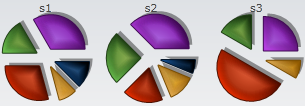Value
Result
5

10

Shadow Effects
You can create shadow effects for the data series using the ShadowEffects class. The ShadowEffects class includes the following properties:
Property | Description |
Gets or sets the shadow color. | |
Gets or sets the shadow depth. | |
LightAngle | Gets or sets the light direction. |
Gets or sets the shadow opacity (0-1). | |
Gets or sets the shadow softness. 0 is sharp shadow and 1 is soft shadow. |
Color Property
You can apply any color to the shadow using the Color property.
Depth Property
You can use the Depth property to determine the depth of the shadow. Increasing the Depth value will make the shadow wider and appear further away from its associated object. Decreasing the Depth value will make the shadow narrower and appear closer to its associated object.
The following table illustrates the effects of the Depth property when set to different values.
Value | Result |
5 |
|
10 |
|
LightAngle Property
You can change the angle of the visual rendering for the shadow by setting its LightAngle property to a different degree. The value of the LightAngle property ranges from -180 to 180 degrees.
The following table illustrates the data series with a LightAngle value of 44 degrees and the data seires with a no LightAngle applied to it:
Value | Result |
44 degrees |
|
None |
|
Opacity Property
The Opacity property controls the opacity level for the shadow. You can darken the shadow around the data series by increasing value of the Opacity property. The numerical values range from 0.0 to 1.0. A value of 0 produces no color and a value of 1.0 produces a dark solid color.
The following table illustrates the data series with an Opacity value of 0.3 and the data series with an Opacity value of 1:
Value | Result |
0.3 |
|
1.0 |
|
Softness Property
To make the shadow effects on the dataseries appear softer use the Softness property. A value of 0 will produce a sharp shadow that will make the shadow appear further from its associated object. A value of 1 will produce a soft shadow and make the shadow appear closer to its associated object.
The following table illustrates the data series with a Softness value of 0 and the data seires with a Softness value of 1:
Value | Result |
0 |
|
1 |
|